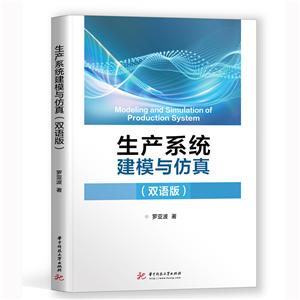-
>
以利為利:財政關系與地方政府行為
-
>
立足飯碗 藏糧于地——基于中國人均耕地警戒值的耕地保護視角
-
>
營銷管理
-
>
茶葉里的全球貿(mào)易史(精裝)
-
>
近代華商股票市場制度與實踐(1872—1937)
-
>
麥肯錫圖表工作法
-
>
海龜交易法則
生產(chǎn)系統(tǒng)建模與仿真:雙語版 版權信息
- ISBN:9787568062176
- 條形碼:9787568062176 ; 978-7-5680-6217-6
- 裝幀:70g膠版紙
- 冊數(shù):暫無
- 重量:暫無
- 所屬分類:>>
生產(chǎn)系統(tǒng)建模與仿真:雙語版 本書特色
本書由武漢理工大學工業(yè)工程專業(yè)責任教授羅亞波整理該課程十余年的教學積累,撰寫而成。全書為雙語版,滿足多種教學環(huán)境需求。全書可分為三大部分:生產(chǎn)系統(tǒng)建模基礎理論、生產(chǎn)系統(tǒng)求解方法、生產(chǎn)系統(tǒng)建模與仿真課程設計的內(nèi)容。 本書可以作為工業(yè)工程專業(yè)本科生和研究生教學用書,也可以作為管理學科相關專業(yè)的教材,并為企業(yè)生產(chǎn)管理人員提供參考。
生產(chǎn)系統(tǒng)建模與仿真:雙語版 內(nèi)容簡介
“生產(chǎn)系統(tǒng)建模與仿真”是工業(yè)工程專業(yè)的一門主干課程,既涉及較深的數(shù)學理論知識,又涉及在生產(chǎn)運作領域的應用方法。在武漢理工大學“十三五”規(guī)劃教材項目支持下,整理該課程十余年的教學積累,筆者撰寫了這一本雙語版教材。全書可分為三大部分:第1章至第4章為生產(chǎn)系統(tǒng)建模基礎理論,介紹了復雜系統(tǒng)的主要特征、系統(tǒng)建模基礎、生產(chǎn)系統(tǒng)優(yōu)化模型、生產(chǎn)系統(tǒng)中的概率問題;第5章至第8章為,介紹了典型的傳統(tǒng)優(yōu)化方法與先進仿生算法的原理及其在生產(chǎn)系統(tǒng)求解中的應用方法;第9章介紹了生產(chǎn)系統(tǒng)建模與仿真課程設計的內(nèi)容,是對前兩部分所學理論與方法的一次綜合實踐。 本書可以作為工業(yè)工程專業(yè)本科生和研究生教學用書,也可以作為管理學科相關專業(yè)的教材,并為企業(yè)生產(chǎn)管理人員提供參考。
生產(chǎn)系統(tǒng)建模與仿真:雙語版 目錄
1.1生產(chǎn)系統(tǒng)的特征(1)
1.2生產(chǎn)系統(tǒng)的分類(1)
1.3生產(chǎn)系統(tǒng)的演化歷史(2)
1.4生產(chǎn)系統(tǒng)建模與仿真的必要性與目標(3)
第2章系統(tǒng)建模基礎(5)
2.1系統(tǒng)的概念(5)
2.2系統(tǒng)建模的一般方法(6)
2.3NPC問題與NPHard問題(8)
2.4三類系統(tǒng)建模問題實例解析(12)
第3章生產(chǎn)系統(tǒng)優(yōu)化模型(16)
3.1生產(chǎn)系統(tǒng)建模概論(16)
3.2單機調(diào)度模型(17)
3.3并行機調(diào)度模型(18)
3.4獨立作業(yè)系統(tǒng)調(diào)度模型(19)
3.5作業(yè)車間調(diào)度問題(22)
第4章生產(chǎn)系統(tǒng)中的概率問題(26)
4.1概率分析方法的應用概論(26)
4.2概率論的幾個基本概念(27)
4.3中心極限定理(31)
4.4隊列特征分析(33)
4.5小結(37)
第5章基于復合形法的生產(chǎn)系統(tǒng)求解方法(38)
5.1復合形法的基本思想和一般步驟(38)
5.2復合形法求解實例(41)
5.3復合形法在作業(yè)車間調(diào)度優(yōu)化中的應用(45)
第6章遺傳算法及其在生產(chǎn)調(diào)度中的應用(51)
6.1遺傳算法的形成和發(fā)展(51)
6.2遺傳算法基礎(52)
6.3遺傳算法應用實例——車間設備布局優(yōu)化(55)
6.4遺傳算法應用實例——裝箱問題(59)
6.5遺傳算法求解作業(yè)車間調(diào)度問題(60)
6.6小結(62)
第7章蟻群算法及其在生產(chǎn)系統(tǒng)優(yōu)化中的應用(63)
7.1蟻群算法概述(63)
7.2蟻群算法的基本原理(64)
7.3蟻群算法求解實例(70)
7.4小結(74)
第8章生產(chǎn)線平衡理論與方法(75)
8.1生產(chǎn)流水線(75)
8.2混流生產(chǎn)線(85)
第9章生產(chǎn)系統(tǒng)建模與仿真課程設計(91)
9.1課程設計任務描述(91)
9.2小規(guī)模作業(yè)車間調(diào)度問題求解示例(91)
9.3中等規(guī)模作業(yè)車間調(diào)度問題求解示例(95)
9.4小結(102)
參 考 文 獻(103)
Chapter 1Introduction(108)
1.1Characteristics of the Production System(108)
1.2Classification of the Production System(109)
1.3Evolution History of the Production System(110)
1.4Necessity and Objectives of Modeling and Simulation of Production System
(112)
Chapter 2The Basis of System Modeling(114)
2.1The Concept of “System”(114)
2.2General Method for System Modeling(116)
2.3NPC Problem and NPHard Problem(118)
2.4Instance Analysis of Three Types of System Modeling Problem(123)
Chapter 3Optimization Model of Production System(128)
3.1Introduction of Production System Modeling(128)
3.2The Model of Single Machine Scheduling(130)
3.3The Model of Parallel Machine Scheduling(131)
3.4The Model of Independent Job System Scheduling(132)
3.5Job Shop Scheduling Problem(135)
Chapter 4The Analysis of Probability in Production System(139)
4.1Introduction to the Application of Probabilistic Analysis Method(139)
4.2Some Basic Concepts of Probability Theory(140)
4.3Central Limit Theorem(145)
4.4Queuing Characteristics Analysis(149)
4.5Summary(153)
Chapter 5Production System Solution Based on Complex Method(154)
5.1Basic Idea and General Steps of Complex Method(154)
5.2Examples of the Complex Method(157)
5.3Application of Complex Method in Job Shop Scheduling Problem(162)
Chapter 6Genetic Algorithm and Its Application in Production Scheduling(169)
6.1Formation and Development of Genetic Algorithm(169)
6.2Genetic Algorithm Foundation(170)
6.3Genetic Algorithm Application Case—Workshop Equipment Layout Optimization
(174)
6.4Genetic Algorithm Application Case—Packing Problem(179)
6.5Solving Job Shop Scheduling Problems by GA(180)
6.6Summary(183)
Chapter 7Ant Colony Algorithm and Its Application in Production System Optimization
(184)
7.1An Overview of Ant Colony Algorithm(184)
7.2The Basic Principle of Ant Colony Algorithm(185)
7.3The Case of Ant Colony Algorithm(193)
7.4Summary(198)
Chapter 8The Theory and Approach of Production Line Balance(199)
8.1Production and Assembly Line(199)
8.2Mixed Production Line(212)
Chapter 9Course Design of Production System Modeling and Simulation(219)
9.1Task Description of Course Design(219)
9.2A Case of a SmallScale Job Shop Scheduling Problem(219)
9.3A Case of a MediumScale Job Shop Scheduling Problem(223)
9.4Summary(230)
Reference(231)
Chapter 1Introduction(105)
1.1Characteristics of the Production System(105)
1.2Classification of the Production System(106)
1.3Evolution History of the Production System(107)
1.4Necessity and Objectives of Modeling and Simulating Production System
(109)
Chapter 2The Basis of System Modeling(111)
2.1The Concept of “System”(111)
2.2General Method for System Modeling(113)
2.3NP Complete Problem and NPHard Problem(115)
2.4Instance Analysis of Three Types of System Modeling Problem(120)
Chapter 3Optimization Model of Production System(125)
3.1Introduction toProduction System Modeling(125)
3.2TheModel of Single Machine Scheduling(127)
3.3TheModel of Parallel Machine Scheduling(128)
3.4The Model of Independent Job System Scheduling(129)
3.5JobShop Scheduling Problem(132)
Chapter 4The Analysis of Probability in Production System(136)
4.1Introduction to the Application of Probabilistic Analysis Method(136)
4.2Some Basic Concepts of Probability Theory(137)
4.3Central limit Theorem(142)
4.4Queuing Characteristics Analysis(146)
5Summary(150)
Chapter 5Production System Solution Based on Comples Method(151)
5.1Basic Idea and General Steps of Complex Method(151)
5.2Examples of the Complex Method(154)
5.3Application of Complex Method in Job Shop Scheduling Problem(159)
Chapter 6Genetic Algorithm and Its Application in Production Scheduling(166)
6.1Formation and Development of Genetic Algorithm(166)
6.2Genetic Algorithm Foundation(167)
6.3Genetic Algorithm Application Case—Workshop Layout Optimization
(171)
6.4Genetic Algorithm Application Case—Packing Problem(176)
6.5Solving Job Shop Scheduling Problems by GA(177)
6Summary(180)
Chapter 7Ant Colony Algorithm and Its Application in Production System Optimization
(181)
7.1An Overview of Ant Colony Algorithm(181)
7.2The Basic Principle of Ant Colony Algorithm(182)
7.3The Case of Ant Colony Algorithm(190)
4Application and Summary(195)
Chapter 8The Theory and Approach of Production Line Balance(196)
8.1Introduction to Production and Assembly Line(196)
8.2Mixed Production Line(208)
Chapter 9Course Design of Production System Modeling and Simulation(216)
9.1Task Description of Course Design(216)
9.2A Case of SmallScale Job Shop Scheduling Problem(216)
9.3A Case of a MediumScale Job Shop Scheduling Problem(220)
4Summary(227)
Reference(228)
生產(chǎn)系統(tǒng)建模與仿真:雙語版 節(jié)選
本書由武漢理工大學工業(yè)工程專業(yè)責任教授羅亞波整理該課程十余年的教學積累,撰寫而成。全書為雙語版,滿足多種教學環(huán)境需求。全書可分為三大部分:生產(chǎn)系統(tǒng)建模基礎理論、生產(chǎn)系統(tǒng)求解方法、生產(chǎn)系統(tǒng)建模與仿真課程設計的內(nèi)容。 本書可以作為工業(yè)工程專業(yè)本科生和研究生教學用書,也可以作為管理學科相關專業(yè)的教材,并為企業(yè)生產(chǎn)管理人員提供參考。
生產(chǎn)系統(tǒng)建模與仿真:雙語版 作者簡介
羅亞波,1973年出生,博士、教授、博士生導師,武漢理工大學工業(yè)工程專業(yè)責任教授。2002—2004年在清華大學控制科學與工程專業(yè)從事博士后研究工作;2005年獲得湖北省杰出青年科學基金。在仿生算法及其應用、復雜系統(tǒng)優(yōu)化與仿真領域開展研究工作,相關成果曾獲湖北省科技進步獎一等獎、湖北省自然科學優(yōu)秀學術論文獎特等獎、中國機械工業(yè)科學技術獎二等獎等。已出版專著和教材共3部,發(fā)表學術論文70余篇,獲軟件著作權9項。
- >
龍榆生:詞曲概論/大家小書
- >
名家?guī)阕x魯迅:朝花夕拾
- >
伯納黛特,你要去哪(2021新版)
- >
山海經(jīng)
- >
我與地壇
- >
小考拉的故事-套裝共3冊
- >
中國人在烏蘇里邊疆區(qū):歷史與人類學概述
- >
中國歷史的瞬間















